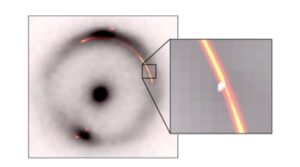An international research team has employed the combined powers of several observatories and gravitational lensing to create a super telescope sensitive enough to spot what the team termed a “mystery dark object” too faint for any single observatory to detect on its own.
Led by Devon Powell at the Max Planck Institute for Astrophysics (MPA) in Germany, the research team, rather than imaging the object directly, employed gravitational lensing, which uses the gravitational field of a massive object like a black hole or a star positioned between the observer and the object, to magnify the targeted object’s light like a lens in a telescope. In this case, the team measured the gravitational lensing effects of the mystery object by observing how light from behind it was warped as it passed.
 The black ring and central dot show an infrared image of a distant galaxy distorted by a gravitational lens. Orange/reg shows radio waves from the same object. The inset shows a pinch caused by another, much smaller, dark gravitational lens (white blob). Image Credit: Devon Powell, Max Planck Institute for Astrophysics.
The black ring and central dot show an infrared image of a distant galaxy distorted by a gravitational lens. Orange/reg shows radio waves from the same object. The inset shows a pinch caused by another, much smaller, dark gravitational lens (white blob). Image Credit: Devon Powell, Max Planck Institute for Astrophysics.
Although the mysterious object, which is approximately 1 billion times more massive than the sun, remains unidentified, the researchers suggest it could be a “clump of dark matter 100 times smaller than any previously detected.” They also said the object might be a “very compact, inactive dwarf galaxy.”
Another factor making identification difficult is the object’s isolation from any stars or galaxies. The team noted that a key question for astronomers is “whether dark matter can exist in small clumps without any stars.” Such a determination could confirm or refute some theories about the nature of dark matter.
According to a statement announcing the object, the research team combined data from several instruments worldwide, including the Green Bank Telescope (GBT) in West Virginia, the Very Long Baseline Array (VLBA) in Hawaiʻi, and the European Very Long Baseline Interferometric Network (EVN). The EVN network includes radio telescopes in Europe, Asia, South Africa, and Puerto Rico.
By working together, the team said the observatories created an “Earth-sized super-telescope,” sensitive enough to successfully capture the subtle signals of gravitational lensing associated with the mysterious dark object.
“It’s an impressive achievement to detect such a low mass object at such a large distance from us,” said Chris Fassnacht, professor in the Department of Physics and Astronomy at the University of California, Davis, who is a co-author on the paper detailing the discovery. “Finding low-mass objects such as this one is critical for learning about the nature of dark matter.”
In fact, the team said they had to increase the resolution of the super-telescope’s image even beyond gravitational lensing by adding a “pinch” to the image. In their release, the researchers compared the added component to a dip in a fun house mirror that focuses the surrounding light to further amplify an image. In this case, the effect captured the mystery object hiding in plain sight.
While the team has yet to confirm the object’s identity, Powell said they were expecting to find “at least one dark object” given the combined sensitivity of the Earth-sized super telescope. Since they did find what they were looking for, Powell notes that spotting this mystery dark object at this sensitivity level is “consistent with the so-called ‘cold dark matter theory’ on which much of our understanding of how galaxies form is based.”
“Having found one, the question now is whether we can find more and whether the numbers will still agree with the models,” the Max Planck researcher added.
Along with planned further analysis of the data to “better understand the nature of the object,” the team plans to look for similar mystery dark objects in other parts of the sky. Since the super-telescope was able to detect what they described as a hundred-fold lower mass object than any found by this technique, they believe the approach could be used to find similar objects.
The team is further analyzing the data to better understand the nature of the dark object and looking for more examples of such dark objects in other parts of the sky.
The study “A million-solar-mass object detected at a cosmological distance using gravitational imaging” was published in Nature Astronomy.
Christopher Plain is a Science Fiction and Fantasy novelist and Head Science Writer at The Debrief. Follow and connect with him on X, learn about his books at plainfiction.com, or email him directly at christopher@thedebrief.org.


